The game of cricket has evolved over a period of time, and with that, the color of the Cricket balls have changed too! You may often see cricket matches being played with different colored cricket balls. But, what is the difference between the Red, White, and Pink cricket balls?
Traditionally, red cricket balls have been used in Test Matches whereas White cricket balls are now used exclusively in limited-overs cricket. Pink Cricket Balls are used only in Day-Night Test Matches. Moreover, Red and Pink cricket balls undergo less wear and tear, whereas White balls tend to swing more.
The overall performance of the different colored balls varies depending on the way the ball is made or the material used in the seam and the kind of coating applied to the surface of the ball.
Thus, to truly understand the difference (and similarities) between the different types of cricket ball, we need to first understand how they are made.
How is the Red Cricket Ball made? What are the Materials Used?
Before going into the details of White and Pink color balls, it is extremely important to know how the traditional Red Cricket balls are made and what kind of materials are used in it.
The following section mostly refers to the Red ball, while the sections referring to the White and Pink color balls would highlight the deviation in this process or the material used making the ball.
Materials Used for Making a Red Cricket Ball

The traditional Red cricket ball is made from leather, Cork, and a stitching thread. Cork is obtained from the outer layer of the bark of the cork oak, and it forms the core of a Cricket ball. It is layered with tightly wound twine and covered by a leather case.

The cross-section is easier to understanding when referencing the rendered model of a cricket ball as shown in the image above.
Process of Making the Red Cricket Ball
A lot of hardship and skill is required to make Cricket balls. With the materials mentioned in the previous section, the Cricket balls are manufactured in the following six key processing steps:
Step 1 – Leather Processing
The process of making a traditional cricket ball begins with leather processing. The processing of leather involves purification of leather followed by dying it with Red color. High-quality leather is chosen to ensure that the ball lasts long.
Step 2 – Cutting and Stitching
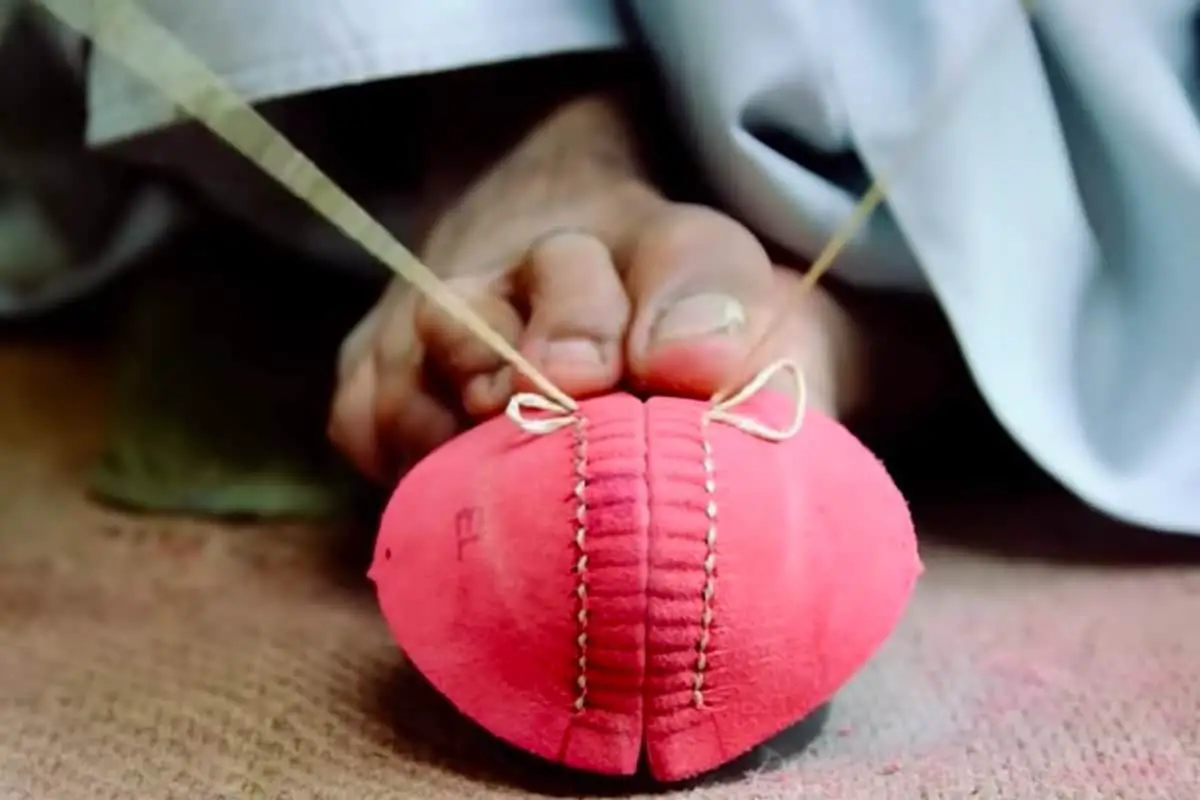
After dying is finished, the leather that is ideal for the ball is chosen. The leather is then cut into two pieces.
These pieces are then pushed into a semi-circle like shapes that form the two halves of a cricket ball. These shapes are held together with the help of the stitches.
The stitches are done using the help of stitching tools. Some cricket balls are often hand-stitched.
Step 3: Assembly

The next step is to take the leather pieces and assemble the cricket ball before beginning the final stitching process. The stitched leather and cork ball are assembled in a manual assembly process.
Step 4: Final stitching
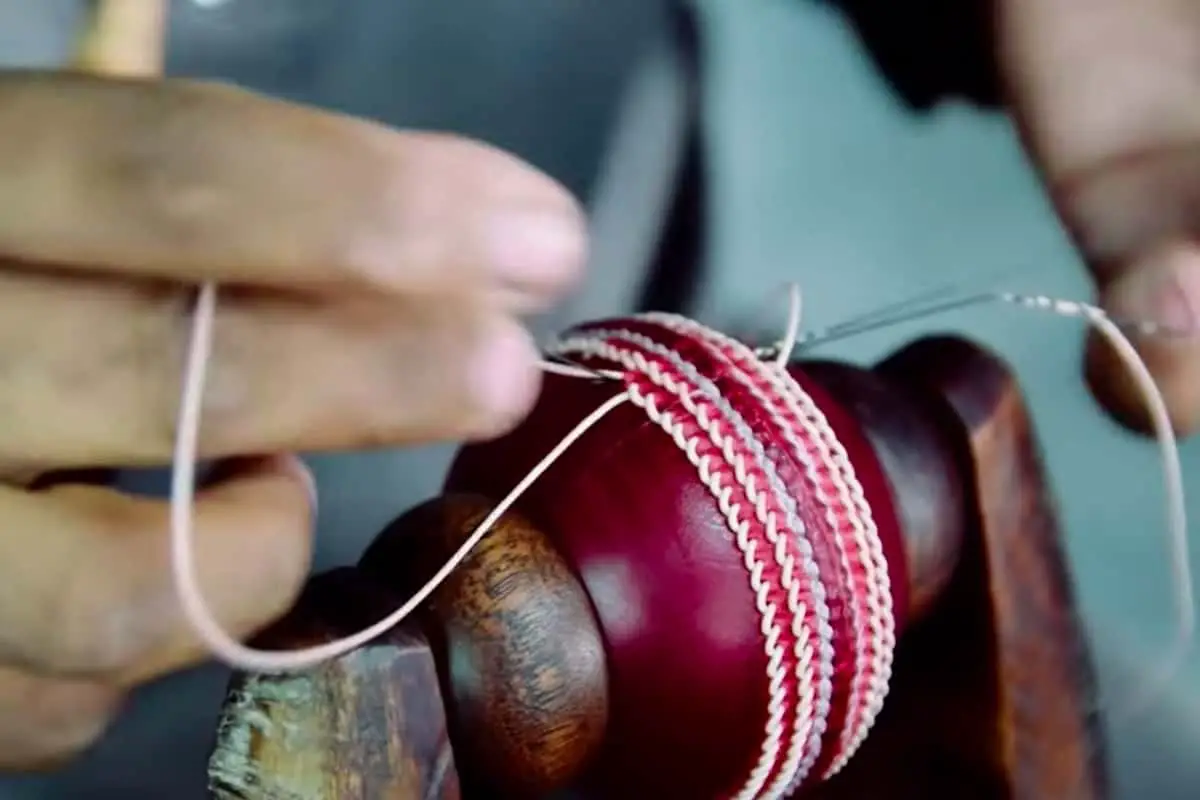
In the final stitching process, an operator gives around anywhere from 60 to about 80 nice-looking stitches to hold the ball assembly. A duke’s cricket ball has exactly 80 stitches on the leather.
The ball may either be completely hand-stitched or could be stitched using a machine.
A cricket ball has 6 layers of stitches. The first two layers of the stitching bind the two halves of leather together. Whereas, the next two layers on each side of the two halves, make sure that the ball remain tight and intact for the expected duration during a cricket match.
Step 5: Pressing & Milling
Once the stitching of the ball is complete, the seam is often quite raised. Furthermore, the ball is not completely rounded shape.
To get the perfectly round shape of the ball, the stitched leather ball is put into a press machine. The machine consists of an upper and lower jaw. After placing the ball between the two jaws, an operator applies the pressure on the ball to get the perfect shape. This process is called Milling.
Step 6: Branding, Lamping and Polishing
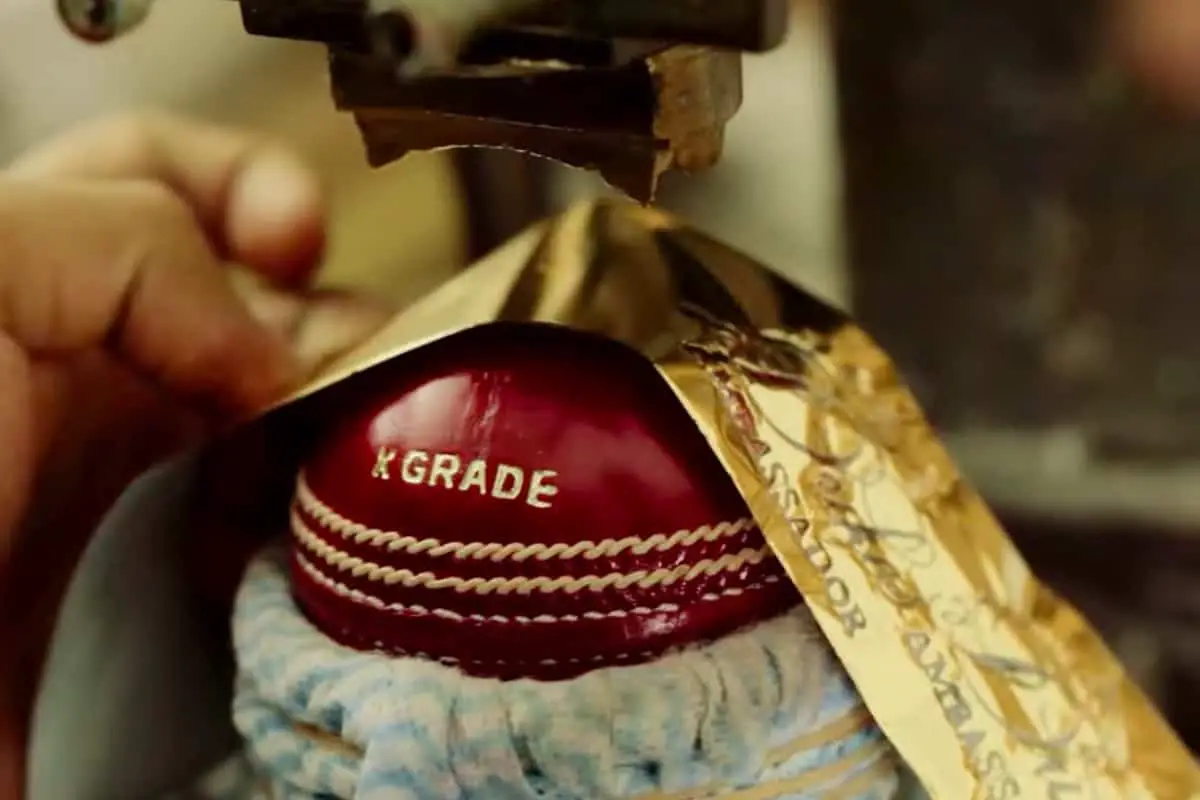
The next step is to imprint the branding on the perfectly-shaped Red leather ball. One might wonder how a curved surface of a cricket ball is branded? The branding on a cricket ball is usually done using a heat-sealed gold foil stamping.
Once the branding is complete, the ball undergoes the process of lamping. This is done in order to distribute the residual wax of the leather consistently throughout the surface of the ball using a source of light; usually a lamp or a candle.
Finally, the polishing of the ball takes place to get the shine that you see on a new cricket ball. This polishing is an important step to ensure the swinging of the ball.
The above video gives a brief but perfect explanation of the process of making a red leather cricket ball.
What are the Dimensions of a Cricket Ball?
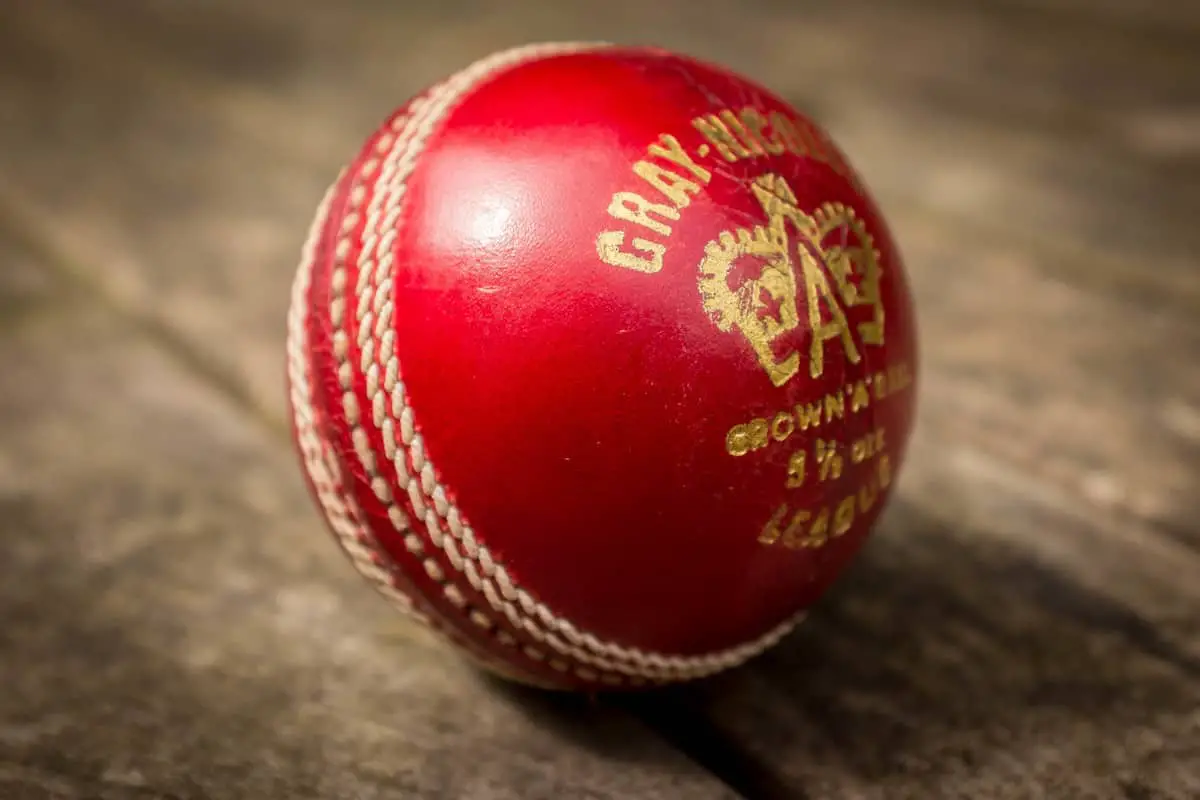
Have you ever wondered what is the actual size of the Cricket ball, what is its weight and how hard is it actually? Let’s get to know it.
Ball Dimensions –
For Men’s Cricket, the diameter of a Cricket ball is between 2.80 to 2.86 inches (71.3 mm to 72.9 mm), while its circumference is 8.81 to 9 inches (224 to 229 mm). For Women’s Cricket, the circumference remains between 8.25 and 8.88 inches (210 to 226 mm).
Ball weight –
A cricket ball weighs between 5.5 and 5.75 ounces (155.9 to 163 g) for Men’s Cricket while for the Women’s Cricket, it weighs around 4.94 to 5.31 ounces (140 to 151 g), at least 10 grams more than a ball used in the game of baseball.
Hardness –
The Cricket balls are harder compared to balls used in other sports like tennis or baseball. It is due to the use of leather, which is much heavier than a rubber or tennis ball. The cricket balls don’t fly away in the air; rather it travels with some velocity from the bat given to it.
Difference Between Red, White and Pink Cricket Balls
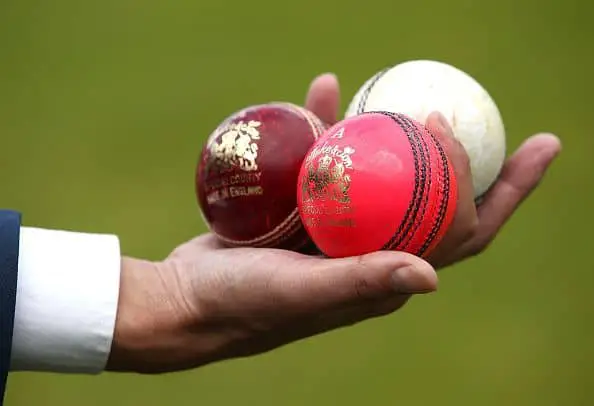
Now that we know how the traditional Red Cricket balls are made and the materials used in it, let’s see how White and Pink balls are different.
Difference Between Red and White Cricket Balls –
Apart from the change in color, White balls are made exactly the same way and using the same material as the Red balls. However, what makes White balls different than Red balls is not just color. Differences between the two cricket balls are described below –
1. Usage –
While Red Cricket balls are used only for the Test and First-Class matches, White balls are used in limited-overs games i.e. Twenty-20 and One-Day matches.
2. Visibility: Day or Night games –
The Red balls are not suited for night games as under floodlights they turn brownish. White balls are way better in terms of visibility under floodlights. Besides, while watching a match on television sets, the White color ball pops nicely.
3. Durability and Appearance
Red balls are more durable than white balls. Due to this reason, the red cricket balls can be used for 80 overs or more. White cricket balls deteriorate quicker, hence they are more suited for limited-overs games.
Also, white balls become dirty or dull in color much quicker than Red balls. Thus, white balls sometimes camouflage with the crowd in the background.
4. Hardness
White balls get scuffs and marks more than Red balls. To avoid it getting dirty quickly, the harder-wearing coating is applied to the White balls. This coating makes the White balls slightly harder than the Red balls. The White ball gets more smoothness and becomes shiny due to the coating and it contributes to more swing compared to the Red ball.
Difference Between Red and Pink Cricket Balls –
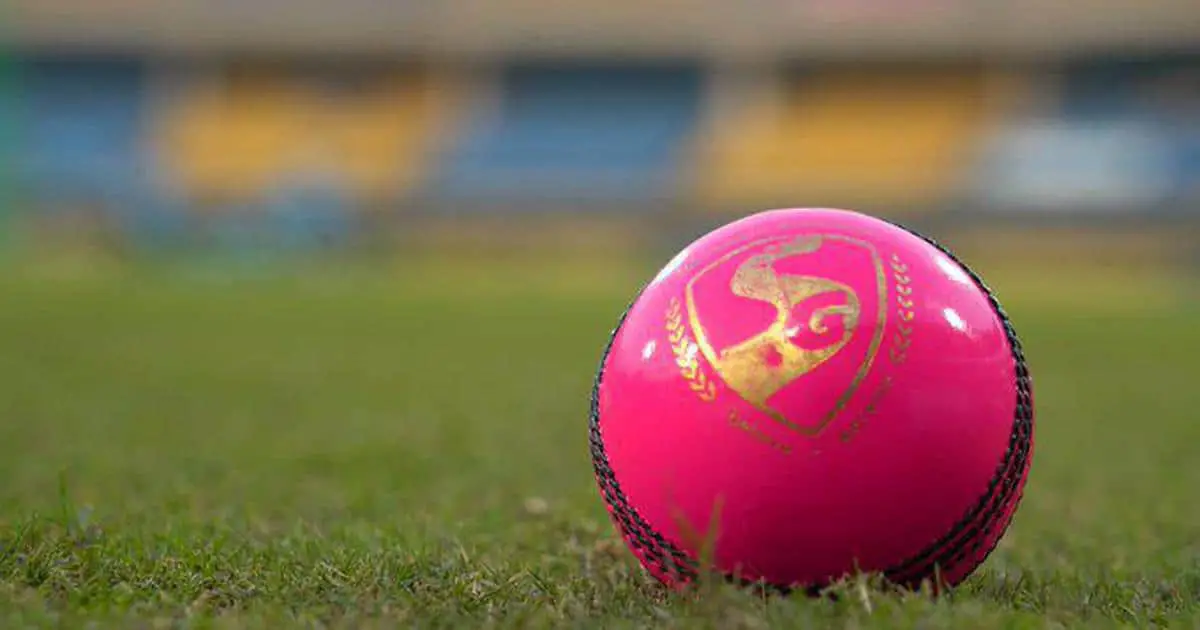
While both the balls are used in Test Cricket, there is a significant difference between the two color balls apart from just the color.
1. Leather and color processing
The key difference between the Pink and Red ball is the way leather is processed and the color is applied. In the case of Red balls, the color is applied by dying it with Red color. The Red ball gets its color from the dying.
In the case of the Pink Cricket balls, the color is because of a pigment with which the leather is coated.
2. Visibility: Day or Night games
The most basic difference between the Pink Ball and the Red ball is their visibility under floodlights.
Pink color balls are much better in terms of visibility under floodlights, making them suitable for the Night matches. Red balls turn brownish under floodlights making it difficult to spot, hence they are not suitable for the Day-Night Test matches.
3. Thread Color
For Red Cricket balls, White threads are used, while for the Pink color balls black threads are used for the seam.
4. Seam
Seam for the Red ball is fully made up of synthetic material, while the Pink ball seam is made up of synthetic and linen mixed in proper proportion.
5. Dew effect and grip
Pink balls are better to grip during dew compared to the Red balls. The linen present in the Pink ball seam absorbs the dew and hence helps with a better grip.
6. Coating and its effect
For Red balls, the wax coating is used, but in the case of Pink balls, wax cannot be applied as it would make the ball darker and difficult to spot under floodlights.
Thus, in PU (polyurethane) coat is used for the Pink balls. Polyurethane also protects the ball from corrosion and scuffs.
7. Swing and bounce
Red cricket balls exhibit good swing and bounce till the first 15 overs, while Pink balls swing and bounce even after 40 overs. This is because of the PU coating used in the Pink ball, which does not come out easily, keeping it relatively new for a long period of time.
Difference Between White and Pink Cricket Balls –
There are more similarities between White and Pink balls than differences. The Pink balls are relatively new in the game, while both the colors balls are introduced to play in the nighttime, under floodlights.
1. Usage
While White Cricket balls are used for the Twenty-20 and One-Day matches, Pink balls are used for Day-Night Test matches.
2. Visibility: Day or Night games
Both the balls are suited in the nighttime under floodlights and hence used for Day-Night games.
3. Durability and appearance
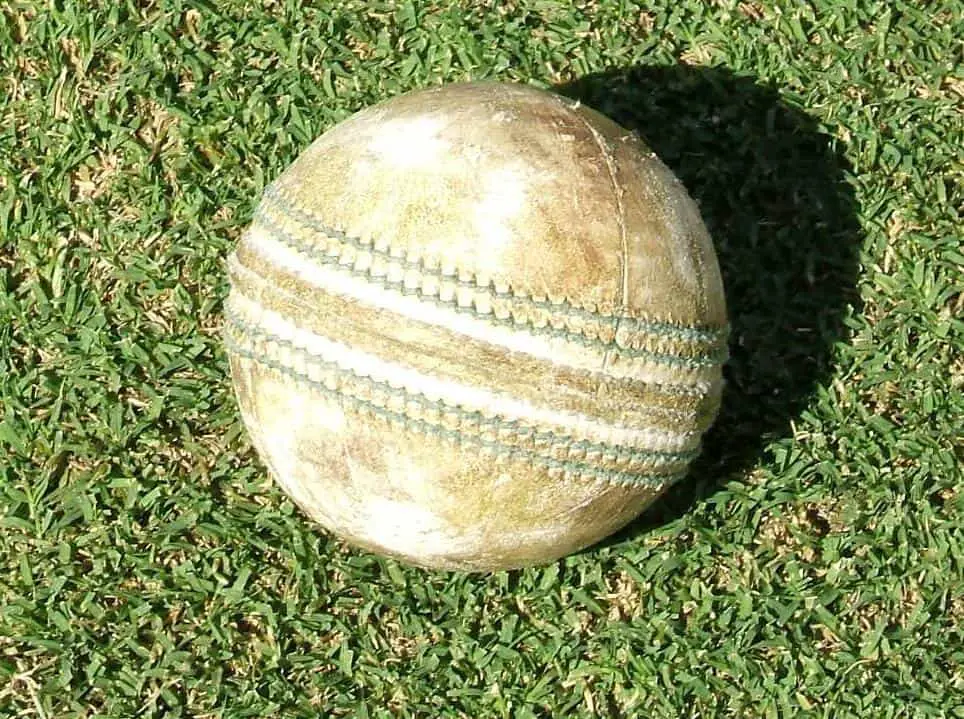
Photograph made by YellowMonkey/Blnguyen, CC BY-SA 4.0, https://commons.wikimedia.org/w/index.php?curid=5911782
Pink balls are more durable than the White balls, and due to this, they can be used for the longer format of the game i.e. Test Cricket. Also, White balls become dirty or dull in color while Pink color balls maintain their color for a longer period of time.
4. Seam
Seam for the White ball is crisper and fully synthetic, whereas the Pink ball seam is a mixture of synthetic and linen.
5. Dew effect and grip
With dew coming into the play, Pink balls are better to grip compared to White balls due to the use of linen in the seam as it absorbs the dew.
6. Coating and its effect
PU (polyurethane) coat is used for the Pink balls while for White balls, the harder-wearing coating is applied to save it from dirt and scuffs, making them slightly heavier. The Pink balls, on the other hand, are not polished as much and are lighter compared to White balls.
Why is the Pink Ball Used in Cricket?
The idea of Day-Night matches was coined to increase the footfall at the Test matches, as a large number of followers could watch the matches after work hours.
However, the traditional red leather ball had its limitations in terms of visibility under floodlights. Thus, an alternative was needed for Day-Night Tests and First-Class Cricket.
Eventually, the Pink ball became the apt alternative to the Red ball.
Why was the Color Pink Chosen as an Alternative to the Red ball?
Before Pink color, ball makers had tried optic yellow and bright orange color balls for the day-night games. But in case of the patchy outfield, or less green and more brown outfield, it did not work out that well.
The yellow ball simply discolored quite quickly and was difficult to see. So, it was ruled out quite quickly. It was tried in the Hong Kong Sixes.
The orange ball actually produced the best visibility for a batsman. However, it somehow was not clearly visible for the fielders especially as the ball was hit hard by the batsman and it zipped hard off the bat. Some fielders complained that it formed a comet like trail and it was difficult to spot while fielding.
Thus, the manufacturers settled with the pink color of the ball. Once the Pink color was fixed by Kookaburra- the ball makers, they put a green seam to it, then switched to White and eventually stuck to black after former Australian skipper Steve Smith’s suggestion.
Black seam made the ball more prominent. Notably, Smith was the skipper for Australia in the first-ever Pink ball Test played in 2015.
Timeline of Usage of Red, White and Pink Cricket Balls
Here’s a brief timeline of how the evolution of cricket ball usage has taken place –
- Till 1977, Red balls were used in all forms of Cricket. Nowadays, Red balls are used only in Test and First-Class Cricket matches.
- White balls were first used in World Series Cricket launched in Australia in 1977.
- With the introduction of Day-Night matches, color television sets, and colored clothing, White balls became an inseparable part of One-Day matches and later Twenty-20 games. White ball has more visibility at night than the Red ball and it appears prominently on the screen. As a large number of viewers watch matches online or on television channels, the ball’s visibility is very important.
- The Pink ball was used for the first time in an international match in July 2009 for the One-Day match between the Women’s team of England and Australia.
- In the Men’s International Cricket, the Pink ball was first used in the Day-Night Test match played between Australia and New Zealand in November 2015.
Final Thoughts
I hope the reader must have gained detailed knowledge about the Red, White, and Pink Cricket balls, also how they are made and when they are used.
The Pink color ball I received well by the players could eventually replace traditional Red color ball as the Day-Night Test match is the future of the game. White balls are still best suited for Twenty-20 matches due to its swing and reverse swing features while Pink ball has its limitation with the reverse swing.
The success of the Day-Night tests depends on how well the players can get used to the Pink ball. The ball is in the players’ court now. I believe, at some point in time in the future, we may see a completely different kind of ball, made from different materials, giving it a different color. Will it replace all Red, White and Pink balls? Only time will tell.
